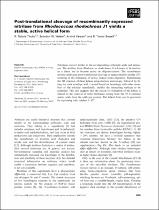| dc.contributor.author | Thuku, Ndoria R. | |
| dc.contributor.author | Weber, Brandon W. | |
| dc.contributor.author | Varsani, Arvind | |
| dc.date.accessioned | 2023-06-05T10:10:38Z | |
| dc.date.available | 2023-06-05T10:10:38Z | |
| dc.date.issued | 2007 | |
| dc.identifier.citation | Thuku, N. R. et al. (2007). Post-translational cleavage of recombinantly expressed nitrilase from Rhodococcus rhodochrous J1 yields a stable, active helical form. The FEBS Journal, 274 (8) , 2099-2108. 10.1111/j.1742-4658.2007.05752.x | en_US |
| dc.identifier.issn | 1742-4658 | |
| dc.identifier.uri | 10.1111/j.1742-4658.2007.05752.x | |
| dc.identifier.uri | http://hdl.handle.net/10566/9014 | |
| dc.description.abstract | Nitrilases convert nitriles to the corresponding carboxylic acids and ammonia.
The nitrilase from Rhodococcus rhodochrous J1 is known to be inactive
as a dimer but to become active on oligomerization. The recombinant
enzyme undergoes post-translational cleavage at approximately residue 327,
resulting in the formation of active, helical homo-oligomers. Determining
the 3D structure of these helices using electron microscopy, followed by fitting
the stain envelope with a model based on homology with other members
of the nitrilase superfamily, enables the interacting surfaces to be
identified. This also suggests that the reason for formation of the helices is
related to the removal of steric hindrance arising from the 39 C-terminal
amino acids from the wild-type protein. The helical form can be generated
by expressing only residues 1–327. | en_US |
| dc.language.iso | en | en_US |
| dc.publisher | Wiley | en_US |
| dc.subject | Biotechnology | en_US |
| dc.subject | Electron microscopy | en_US |
| dc.subject | Nitrilase | en_US |
| dc.subject | Agriculture | en_US |
| dc.subject | Horticulture | en_US |
| dc.title | Post-translational cleavage of recombinantly expressed nitrilase from Rhodococcus rhodochrous J1 yields a stable, active helical form | en_US |
| dc.type | Article | en_US |

